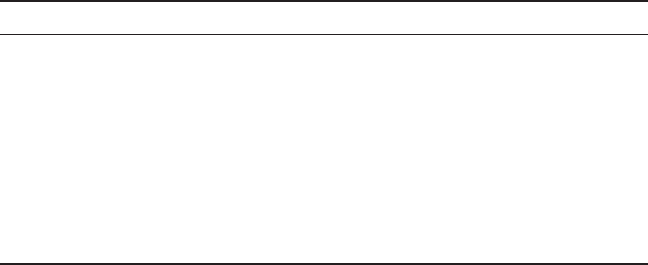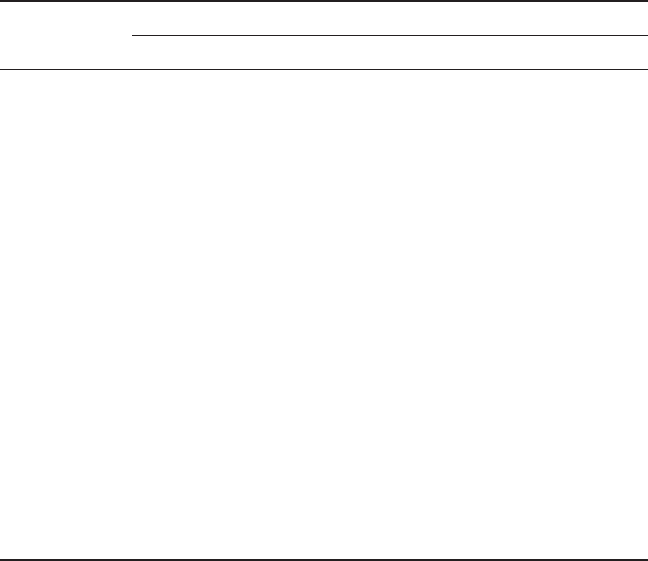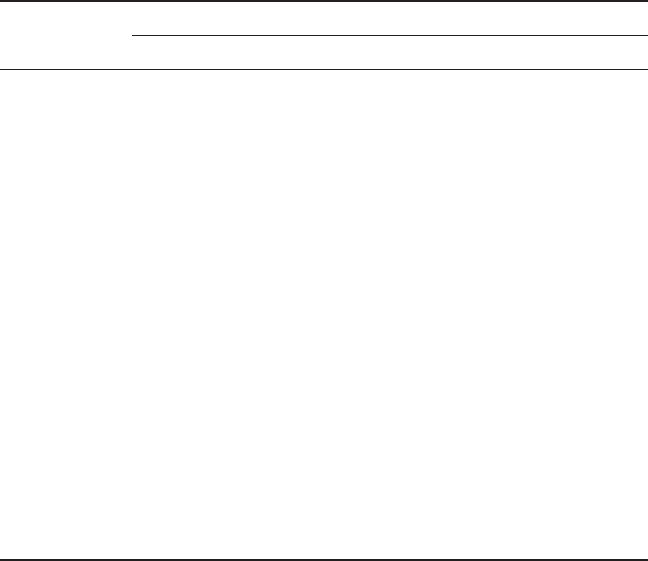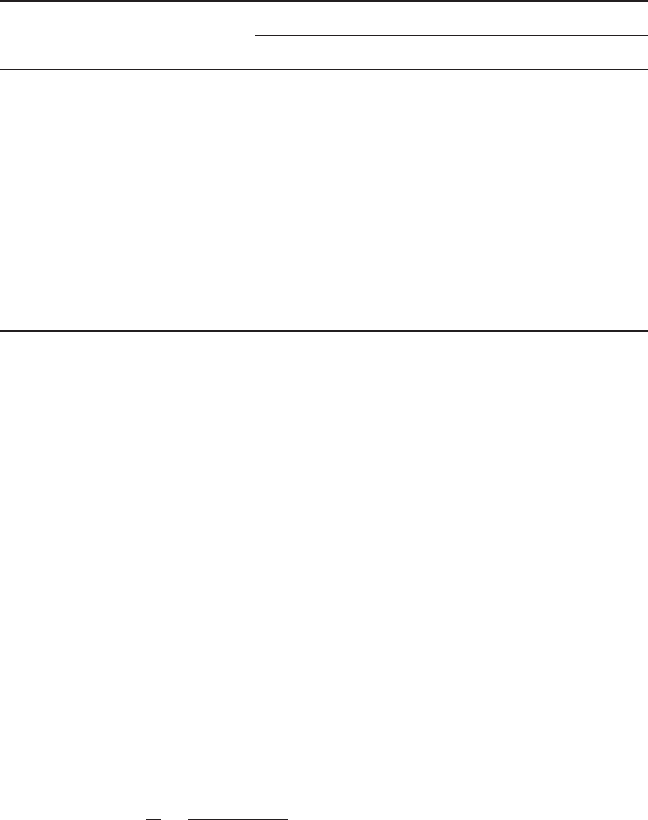Lin S.D. Water and Wastewater Calculations Manual
Подождите немного. Документ загружается.

line can be drawn. However, in practice, most cases do not yield a
straight line relationship. Hom (1972) refined the Chick–Watson model
and developed a flexible, but highly empirical kinetic formation as fol-
lows:
⫺dN/dt ⫽ k′Nt
m
C
n
(5.182)
where m ⫽ empirical constant
⫽ 2 for E. coli
Other variables are as previous stated
For changing concentrations of the disinfectant, the disinfection effi-
ciency is of the following form (Fair et al., 1968):
C
n
t
p
⫽ constant (5.183)
where t
p
is the time required to produce a constant percent of kill or die-
off. This approach has evolved into a “CT” (concentration ⫻ contact time)
regulation to ensure a certain percentage kills of Crypotosporidium,
Giardia, and viruses. The percentage kills are expressed in terms of log
removals.
18.4
CT values
On June 29, 1989, the US Environmental Protection Agency (1989b)
published the final Surface Water Treatment Regulations (SWTR),
which specifies that water treatment plants using surface water as a
source or groundwater under the influence of surface water, and with-
out filtration, must calculate CT values daily. The CT value refers to the
value of disinfectant content or disinfectant residual, C (mg/L), multi-
plied by the contact time, T (minutes, or min). Disinfectants include chlo-
rine, chloramines, ozone, and chlorine dioxide.
Regulations. The US EPA reaffirms its commitment to the current Safe
Drinking Water Act, which includes regulations related to disinfection
and pathogenic organism control for water supplies. Public water supply
utilities must continue to comply with current rules while new rules for
microorganisms and disinfectants/disinfection by-products are being
developed.
The Surface Water Treatment Rule requires treatment for Giardia
and viruses of all surface water and groundwater under the direct influ-
ence of surface water. Public water systems are required to comply with
a new operating parameter, the so-called CT value, an indicator of the
effectiveness of the disinfection process. This parameter depends on pH
and temperature to remove or inactivate Giardia lamblia (a protozoan)
and viruses that could pass through water treatment unit processes.
Public Water Supply 475
Requirements (US EPA, 1999) for treatment (using the best available
technology) such as disinfection and filtration are established in place
of a maximum contaminant level (MCL) for Giardia, Legionella, het-
erotrophic plate count (HPC), and turbidity. Total treatment of the
system must achieve at least 99.9% (3-log) removal or inactivation of
G. lamblia cysts and 99.99% (4-log) removal of inactivation of viruses.
To avoid nitration, a system must demonstrate that its disinfection con-
ditions can achieve the above efficiencies every day of operation except
during any one day each month. Filtered water turbidity must at no time
exceed 5 NTU (nephelo-metric turbidity units), and 95 percent of the tur-
bidity measurements must meet 0.5 NTU for conventional and direct fil-
tration and 1.0 NTU for slow sand filtration and diatomaceous earth
filtration. Turbidity must be measured every 4 h by grab sampling or
continuous monitoring. Cryptosporidium was not regulated by the
SWTR in 1989 because sufficient data about the organism were lacking
at the time.
The residual disinfectant in finished water entering the distribution
system should not be less than 0.2 mg/L for at least 4 h. The residual
disinfectant at any distribution point should be detectable in 95% of the
samples collected in a month for any two consecutive months. A water
plant may use HPC in lieu of residual disinfectant. If HPC is less than
500 per 100 mL, the site is considered to have a detectable residual for
compliance purposes (US EPA, 1989a).
There are some criteria for avoiding filtration. The water plant must
calculate the CT value daily. The water plant using filtration may or may
not need to calculate CT values, depending on state primary require-
ments. The primary agency credits the slow sand filter, which produces
water with turbidity of 0.6 to 0.8 NTU, with 2-log Giardia and virus
removal. Disinfection must achieve an additional 1-log Giardia and
2-log virus removal/inactivation to meet the overall treatment objective.
The Interim Enhanced Surface Water Treatment Rule (US EPA,
1999a) defines a disinfection profile as a compilation of daily Giardia
and/or virus log inactivations over a period of a year or more (may be
3 years). Inactivation of pathogens is typically reported in orders of
magnitude inactivation of organisms on a logarithmic scale.
The disinfection profile is a graphical representation of the magnitude
of daily Giardia or virus log inactivation that is developed, in part,
based on daily measurements of operational data (disinfectant residual
concentration, contact time, pH, and temperature). A plot of daily log
inactivation values versus time provides a visual representation of the
log inactivation the treatment system achieved over time. Changes in
log inactivation due to disinfectant residual concentrations, tempera-
ture, flow rate, or other changes can be seen from this plot (US EPA,
1999b).
476 Chapter 5
Determination of CT values. Calculation of CT values is a complicated
procedure depending on the configuration of the whole treatment
system, type and number of point applications, and residual concen-
tration of disinfectant (Pontius, 1993).
A water utility may determine the inactivation efficiency based on one
point of disinfectant residual measurement prior to the first customer,
or on a profile of the residual concentration between the point of disin-
fectant application and the first customer. The first customer is the
point at which finished water is first consumed. To determine compli-
ance with the inactivation (Giardia and viruses) requirements, a water
system must calculate the CT value(s) for its disinfection conditions
during peak hourly flow once each day that it is delivering water to its
first customers. To calculate CT value, T is the time (in minutes) that
the water moves, during the peak hourly flow, between the point of dis-
infectant application and the point at which C, residual disinfectant con-
centration, is measured prior to the first customer. The residual
disinfectant concentration, C, pH, and temperature should be meas-
ured each day during peak hourly flow at the effluents of treatment
units (each segment or section) and at the first customer’s tap. The seg-
ments may include the inflow piping system, rapid mixer, flocculators,
clarifiers, filters, clearwells, and distribution systems.
The contact time, T, is between the application point and the point of
residual measured or effective detention time (correction factor from
hydraulic retention time, HRT). The contact time in pipelines can be
assumed equivalent to the hydraulic retention time and is calculated by
dividing the internal volume of the pipeline by the peak hourly flow rate
through the pipeline. Due to short circuiting, the contact time in mixing
tanks, flocculators, settling basins, clearwells, and other tankages should
be determined from tracer studies or an equivalent demonstration. The
time determined from tracer studies to be used for calculating CT is T
10
.
In the calculation of CT values, the contact time, designated by T
10
, is
the time needed for 10% of the water to pass through the basin or reser-
voir. In other words, T
10
is the time (in minutes) that 90% of the water
(and microorganisms in the water) will be exposed to disinfectant in the
disinfection contact chamber.
The contact time T
10
is used to calculate the CT value for each sec-
tion. The CT
cal
is calculated for each point of residual measurement.
Then the inactivation ratio, CT
cal
/CT
99.9
or CT
cal
/CT
99
should be calcu-
lated for each section. CT
99.9
and CT
99
are the CT values to achieve
99.9% and 99% inactivation, respectively. Total inactivation ratio is
the sum of the inactivation ratios for each section (sum CT
cal
/CT
99.9
). If
the total inactivation ratio is equal to or greater than 1.0, the system
provides more than 99.9% inactivation of Giardia cysts and meets the
disinfection performance requirement. In fact, many water plants meet
Public Water Supply 477
the CT requirement for 3-log Giardia inactivation because the plant con-
figurations allow for adequate contact time.
Calculation of CT values is a complicated procedure and depends on
the configuration of the entire treatment system, type and number of
point applications, and residual concentration of disinfectant (US EPA,
1999). The water temperature, pH, type and concentration of disinfec-
tant, and effective retention time (ERT) determine the CT values. Flow
patterns and tank configurations of flocculators, clarifiers, and clearwells
(location of influent and effluent pipe, and the baffling condition) affect
the ERT. The ERT is different from the HRT in most instances.
The theoretical contact time, T
theo
, can be determined as (assuming
completely mixed tank):
T
theo
⫽ V/Q (5.184)
where T
theo
⫽ time (⫽ HRT), minutes (min)
V ⫽ volume of tank or pipe, gallons or m
3
Q ⫽ flow rate, gallons per minute, gpm or m
3
/s
The flow rate can be determined by a theoretical calculation or by using
tracer studies. An empirical curve can be developed for T
10
against Q.
For the distribution pipelines, all water passing through the pipe is
assumed to have detention time equal to the theoretical (Eq. (5.184)) or
mean residence time at a particular flow rate, i.e., the contact time is
100% of the time the water remains in the pipe.
In mixing basins, storage reservoirs, and other treatment plant
process units, the water utility is required to determine the contact
time for the calculation of the CT value through tracer studies or other
methods approved by the primacy agency, such as the state EPA.
The calculation of contact time T for treatment units is not a
straightforward process of dividing the volume of tank or basin by the
flow through rate (Eq. 5.184). Only a partial credit is given to take into
account short circuiting that occurs in tanks without baffles. The
instructions on calculating the contact time (out of the scope of this
manual) are given in Appendix C of the Guidance Manual (US EPA,
1989a).
Baffling is used to maximize utilization of basin volume, increase the
plug flow zone in the basin, and to minimize short circuiting. Some form
of baffling is installed at the inlet and outlet of the basin to evenly dis-
tribute flow across the basin. Additional baffling may be installed within
the interior of the basin. Baffling conditions generally are classified as
poor, average, or superior and are based on results of tracer studies for
use in determining T
10
from the theoretical detention time of a tank. The
T
10
/T fractions associated with various degrees of baffling conditions are
478 Chapter 5

shown in Table 5.7. In practice, theoretical T
10
/T values of 1.0 for plug
flows and 0.1 for mixed flow are seldom achieved due to the effect of dead
space. Superior baffling conditions consist of at least a baffled inlet and
outlet, and possibly some intrabasin baffling to redistribute the flow
throughout the basin’s cross section. Average baffling conditions include
intrabasin baffling and either a baffled inlet or outlet. Poor baffling con-
ditions refer to basins without intrabasin baffling and unbaffled inlets
and outlets.
The procedure to determine the inactivation capability of a water plant
is summarized as follows (US EPA, 1989a, 1990, 1999; IEPA, 1992):
1. Determine the peak hourly flow rate (Q in gpm) for each day from
monitoring records.
2. Determine hydraulic detention time: HRT ⫽ T ⫽ V/Q.
3. Calculate the contact time (T
10
) for each disinfection segment based
on baffling factors or tracer studies.
4. Find correction factor, T
10
/T, look at the actual baffling conditions
to obtain T
10
from Table 5.6.
5. Compute effective retention time (ERT) ⫽ HRT ⫻ (T
10
/T).
6. Measure the disinfectant residual: C in mg/L (with pH, and tem-
perature in °C) at any number of points within the treatment train
during peak hourly flow (in gpm).
7. Calculate CT value (CT
cal
) for each point of residual measurement
(using ERT for T) based on actual system data.
8. Find CT
99.9
or CT
99.99
value from Tables 5.7 or 5.9 (from Appendix E
of the Manual, US EPA, 1989a) based on water temperature, pH,
residual disinfectant concentration, and log
10
removal ⫽ 3 or 4.
Public Water Supply 479
TABLE 5.7 Classification of Baffling and T
10
/
T Values
Condition of baffling Description of baffling T
10
/T
Unbaffled (mixed flow) No baffle, agitated basin, very low length-to-width 0.1
ratio, high inlet and outlet flow velocities
Poor Single or multiple unbaffled inlets and outlet, no 0.3
intrabasin baffles
Average Only baffled inlet or outlet, with some intrabasin 0.5
baffles
Superior Perforated inlet baffle, serpentine or perforated 0.7
intrabasin baffles, outlet weir, or perforated launders
Perfect (plug flow) Very high length-to-width ratio (pipeline flow), 1.0
perforated inlet, outlet, and intrabasin baffles
SOURCE: Table C-5 of the US EPA Guidance Manual (US EPA, 1989a)
9. Compute the inactivation ratio, CT
cal
/CT
99.9
and CT
cal
/CT
99.99
for
Giardia and viruses, respectively.
10. Calculate the estimated log inactivation by multiplying the ratio
of step 9 by 3 for Giardia and by 4 for viruses, because CT
99.9
and CT
99.99
are equivalent to 3-log and 4-log inactivations,
respectively.
11. Sum the segment log inactivation of Giardia and viruses (such as
rapid mixing tanks, flocculators, clarifiers, filters, clearwell, and
pipelines) to determine the plant total log inactivations due to
disinfection.
12. Determine whether the inactivations achieved are adequate. If the
sum of the inactivation ratios is greater than or equal to one, the
required 3-log inactivation of Giardia cysts and 4-log viruses inac-
tivation have been achieved.
13. The total percent of inactivation can be determined as:
y ⫽ 100 ⫺ 100/10
x
(5.185)
where y ⫽ % inactivation
x ⫽ log inactivation
Tables 5.8 and 5.9 present the CT values for achieving 99.9% and
99% inactivation of G. lamblia. Table 5.10 presents CT values for
achieving 2-, 3-, and 4-log inactivation of viruses at pH 6 through 9
(US EPA, 1989b). The SWTR Guidance Manual did not include CT
values at pH above 9 due to the limited research results available at
the time of rule promulgation. In November 1997, a new set of pro-
posed rules was developed for the higher pH values, up to pH of 11.5
(Federal Register, 1997).
Example 1: What are the percentages of inactivation for 2- and 3.4-log
removal of Giardia lamblia?
solution: Using Eq. (5.185)
y ⫽ 100 ⫺ 100/10
x
as x ⫽ 2
y ⫽ 100 ⫺ 100/10
2
⫽ 100 ⫺ 1 ⫽ 99(%)
as x ⫽ 3.4
y ⫽ 100 ⫺ 100/10
3.4
⫽ 100 ⫺ 0.04 ⫽ 99.96(%)
Example 2: A water system of 100,000 gpd (0.0044 m
3
/s) using a slow sand
filtration system serves a small town of 1000 persons. The filter effluent turbidity
480 Chapter 5

values are 0.4 to 0.6 NTU and pH is about 7.5. Chlorine is dosed after filtra-
tion and prior to the clearwell. The 4-in (10 cm) transmission pipeline to the
first customer is 1640 ft (500 m) in distance. The residual chlorine concen-
trations in the clearwell and the distribution main are 1.6 and 1.0 mg/L,
respectively. The volume of the clearwell is 70,000 gal (265 m
3
). Determine
Giardia inactivation at a water temperature of 10°C at the peak hour flow of
100 gpm.
solution:
Step 1.
An overall inactivation of 3 logs for Giardia and 4 logs for viruses is
required. The Primacy Agency can credit the slow sand filter process, which
produces water with turbidity ranging from 0.6 to 0.8 NTU, with a 2-log
Giardia and virus inactivation. For this example, the water system meets
the turbidity standards. Thus, disinfection must achieve an additional
Public Water Supply 481
TABLE 5.8
CT Values [(mg/l)min] for Achieving 99.9% (3 log) Inactivation
of Giardia lamblia
Disinfectant,
Temperature, °C
mg/L pH 0.5 or <1 5 10 15 20 25
Free
chlorine
≤0.4 6 137 97 73 49 36 24
7 195 139 104 70 52 35
8 277 198 149 99 74 50
9 390 279 209 140 105 70
1.0 6 148 105 79 53 39 26
7 210 149 112 75 56 37
8 306 216 162 108 81 56
9 437 312 236 156 117 78
1.6 6 157 109 83 56 42 28
7 226 155 119 79 59 40
8 321 227 170 116 87 58
9 466 329 236 169 126 82
2.0 6 165 116 87 58 44 29
7 236 165 126 83 62 41
8 346 263 182 122 91 61
9 500 353 265 177 132 88
3.0 6 181 126 95 63 47 32
7 261 182 137 91 68 46
8 382 268 201 136 101 67
9 552 389 292 195 146 97
ClO
2
6–9 63 26 23 19 15 11
Ozone 6–9 2.9 1.9 1.43 0.95 0.72 0.48
Chloramine 6–9 3800 2200 1850 1500 1100 750
SOURCE: Abstracted from Tables E-1 to E-6, E-8, E-10, and E-12 of the US EPA Guidance
Manual (US EPA, 1989a)

482 Chapter 5
TABLE 5.9 CT Values [(mg/L) min] for Achieving 90% (1 log) Inactivation
of Giardia lamblia
Disinfectant,
Temperature, °C
mg/L pH 0.5 or <1 5 10 15 20 25
Free chlorine
≤ 0.4 6 46 32 24 16 12 8
765 4635231712
892 6650332517
9 130 93 70 47 35 23
1.0 6 49 35 26 18 13 9
770 5037251912
8 101 72 54 36 27 18
9 146 104 78 52 39 26
1.6 6 52 37 28 19 14 9
775 5240262013
8 110 77 58 39 29 19
9 159 112 84 56 42 28
2.0 6 55 39 29 19 15 10
779 5541282114
8 115 81 61 41 30 20
9 167 118 88 59 46 29
3.0 6 60 42 32 21 16 11
787 6146302315
8 127 89 67 45 36 22
9 184 130 97 65 49 32
Chlorine 6–9 21 8.7 7.7 6.3 5.0 3.7
dioxide
Ozone 6–9 0.97 0.63 0.48 0.32 0.24 0.16
Chloramine 6–9 1270 735 615 500 370 250
SOURCE: Abstracted from Tables E-l to E-6, E-8, E-10, and E-12 of the US EPA Guidance
Manual (US EPA, 1989a)
1-log Giardia and 2-log virus removal/inactivation to meet the overall
treatment efficiency.
Step 2. Calculate T
10
at the clearwell (one-half of volume used, see Step 7(a)
of Example 5)
T
10
can be determined by the trace study at the peak hour flow or by
calculation
T
10
⫽ V
10
/Q ⫽ 0.1 ⫻ (70,000gal/2)/(100gal/min)
⫽ 35 min
Step 3. Calculate CT
cal
in the clearwell
CT
cal
⫽ 1.6 mg/L ⫻ 35 min ⫽ 56 (mg/L) min

Step 4. Calculate CT
cal
/CT
99.9
From Table 5.8, for 3-log removal for 1.6 mg/L chlorine residual at 10°C and
pH 7.5
CT
99.9
⫽ 145 (mg/L) min (by linear proportion between pH 7 and 8)
then
CT
cal
/CT
99.9
⫽ 56/145 ⫽ 0.38
Step 5. Calculate contact time at transmission main
where A is the cross-sectional area of the 4-in pipe, and v is the flow velocity.
5 15.5 min
T 5 length/v 5 1640 ft/106 ft/min
5 106 ft/min
v 5
Q
A
5
9.28 ft
3
/min
0.0872 ft
2
A 5 3.14s4 in/2/12 in/ftd
2
5 00872 ft
2
5 9.28 ft
3
/min
Q 5 100,000 gal/d 3 1 ft
3
/7.48 gal 3 1 day/440 min
Public Water Supply 483
TABLE 5.10
CT Values [(mg/L) min] for Achieving Inactivation of Viruses
at pH 6 through 9
Disinfectant Log
Temperature, °C
mg/L inactivation ≤ 1 5 10 15 20 25
Free chlorine 2 6 4 3 2 1 1
3964321
41286432
Chlorine 2 8.4 5.6 4.2 2.8 2.1 1.4
dioxide 3 25.6 17.1 12.8 8.6 6.4 4.3
4 50.1 33.4 25.1 16.7 12.5 8.4
Ozone 2 0.9 0.6 0.5 0.3 0.25 0.15
3 1.4 0.9 0.8 0.5 0.4 0.25
4 1.8 1.2 1.0 0.6 0.5 0.3
Chloramine 2 1243 857 643 428 321 214
3 2063 1423 1067 712 534 365
4 2883 1988 1491 994 746 497
SOURCE: Modified from Tables E-7, E-9, E-ll, and E-13 of the US EPA Guidance Manual
(US EPA, 1989a)
Step 6. Calculate CT
cal
and CT
cal
/CT
99.9
for the pipeline
CT
cal
⫽ 1.0 mg/L ⫻ 15.5 min
⫽ 15.5 (mg/L) min
From Table 5.8, for 3-log removal of 1.0 mg/L chlorine residual at 10°C and
pH 7.5
CT
99.9
⫽ 137 (mg/L) min
then CT
cal
/CT
99.9
⫽ 15.5/137 ⫽ 0.11 (log)
Step 7. Sum of CT
cal
/CT
99.9
from Steps 4 and 6
Total CT
cal
/CT
99.9
⫽ 0.38 ⫹ 0.11 ⫽ 0.49 (log)
Because this calculation is based on a 3-log removal, the ratio needs to
be multiplied by 3. The equivalent Giardia inactivation then is
3 ⫻ total CT
cal
/CT
99.9
⫽ 3 ⫻ 0.49 log ⫽ 1.47 log
The 1.47-log Giardia inactivation by chlorine disinfection in this system
exceeds the 1-log additional inactivation needed to meet the overall treatment
objectives. If a system uses chloramine and is able to achieve CT values for
99.9% inactivation of Giardia cysts, it is not always appropriate to assume
that 99.99% or greater inactivation of viruses also is achieved.
Example 3: For a 2000-ft long, 12-in transmission main with a flow rate of
600 gpm, what is the credit of inactivation of Giardia and viruses using chlo-
rine dioxide (ClO
2
) residual ⫽ 0.6 mg/L, at 5°C and pH 8.5.
solution:
Step 1. Calculate CT
cal
/CT
99.9
for transmission pipe
T ⫽ r
2
L/Q
⫽ 3.14 (0.5 ft)
2
(2000 ft) (7.48 gal/ft
3
)/(600 gal/min)
⫽ 19.6 min
where r is the radius of the pipe and L is the length of the pipe.
CT
cal
⫽ 0.6mg/L ⫻ 19.6 min
⫽ 11.7 (mg/L) min
At 5°C and pH of 8.5, using ClO
2
, from Table 5.7
CT
99.9
⫽ 26 (mg/L) min
Cl
cal
/CT
99.9
⫽ 11.7/26 ⫽ 0.45 (log)
484 Chapter 5
